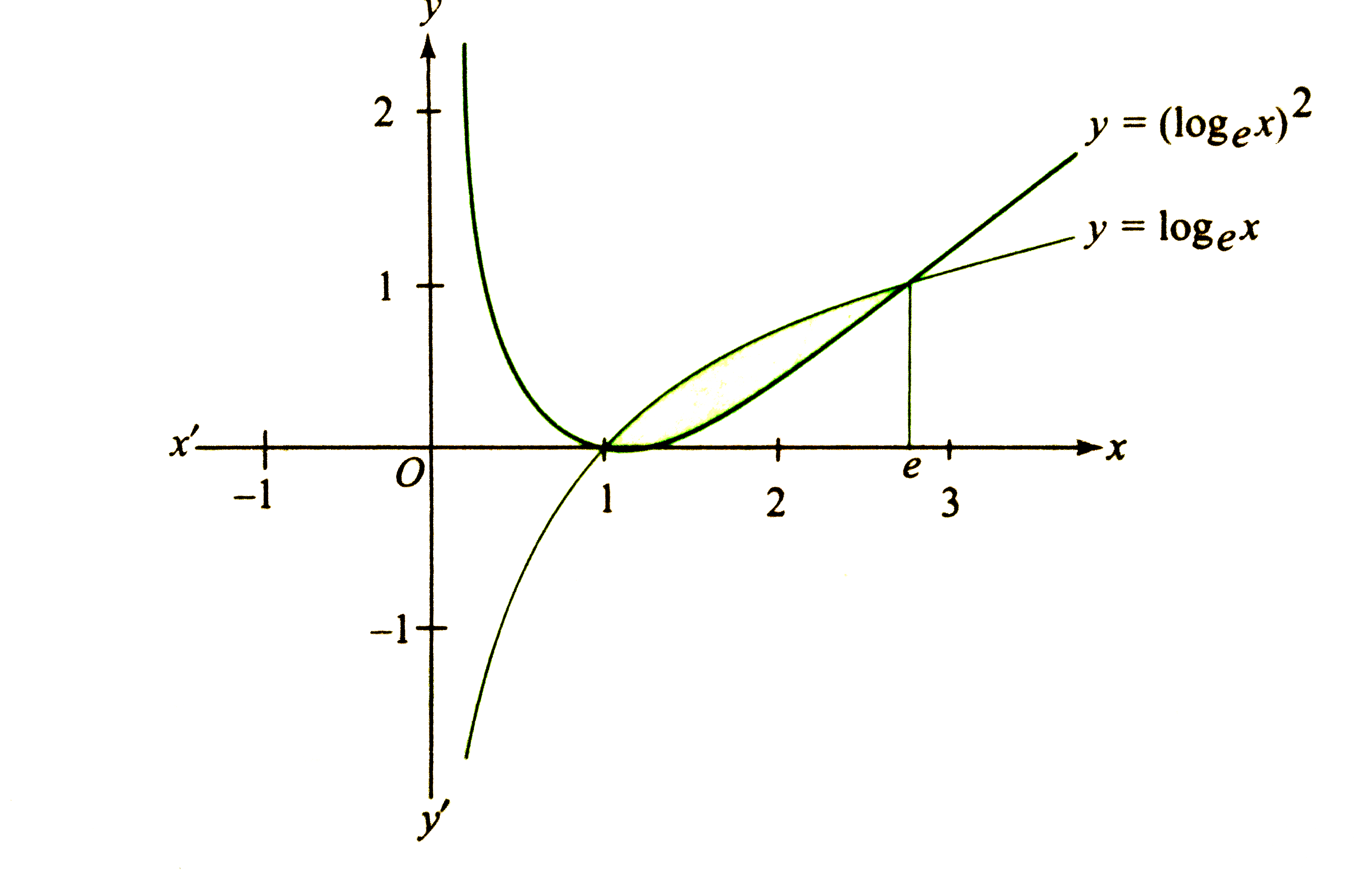The area bounded by the curves y=(log)exandy=((log)ex)2 is e−2sq.units (b) 3−esq.units esq.units (d) e−1sq.unitsSolution in Tamil
e−2 sq. units
3−e sq. units
e sq. units
e−1 sq. units
The correct Answer is:B
Given curves are y=logexandy=(logex)2
Solving logex=(logex)2⇒logex=0,1⇒x=1andx=e
Also, for 1<x<e,0<logex<1⇒logex>(logex)2
For x>e,logex<(logex)2
y=(logex)2>0 for all x>0
and when x→0,(logex)2→∞,
From these information, we can plot the graph of the functions.

∴ Required area =e∫1(logx−(logex)2)dx
=e∫1logxdx−e∫1(logex)2dx
=[xlogex−x]e1−[x(logex)2]e1+e∫12logexxxdx
=1−e+2[xlogex−x]e1
=3−e sq. units
Topper's Solved these Questions
- AREABook:CENGAGEChapter:AREAExercise:Exercise (Multiple)
Explore 10 Videos
- AREABook:CENGAGEChapter:AREAExercise:Exercise (Comprehension)
Explore 21 Videos
- AREABook:CENGAGEChapter:AREAExercise:Exercise 9.3
Explore 7 Videos
- APPLICATIONS OF DERIVATIVESBook:CENGAGEChapter:APPLICATIONS OF DERIVATIVESExercise:Subjective Type
Explore 2 Videos
- AREA UNDER CURVESBook:CENGAGEChapter:AREA UNDER CURVESExercise:Question Bank
Explore 10 Videos
Similar Questions
Let A(k) be the area bounded by the curves y=x2−3 and y=kx+2 The range of A(k) is (10√53,∞) The range of A(k) is (20√53,∞) If function k→A(k) is defined for k∈[−2,∞ ), then A(k) is many-one function. The value of k for which area is minimum is 1.
View SolutionLet Ar be the area of the region bounded between the curves y2=(e−kr)x(where k>0,r∈N) and the line y=mx(where m≠0), k and m are some constants
A1,A2,A3,… are in G.P. with common ratio
View SolutionFind the continuous function f where (x4−4x2)≤f(x)≤(2x2−x3) such that the area bounded by y=f(x),y=x4−4x2. then y-axis, and the line x=t, where (0≤t≤2) is k times the area bounded by y=f(x),y=2x2−x3,y−aξs, and line x=t(where0≤t≤2).
View SolutionProve that for λ>1, the equation xlogx+x=λ has least one solution in [1,λ].
View SolutionThe area of the region (s) enclosed by the curves y=x2 and y=√|x| is
View SolutionThe area enclosed between the curves y=(log)e(x+e),x=(log)e(1y), and the x-axis is 2sq.units (b) 1sq.units 4sq.units (d) none of these
View SolutionThe area of the closed figure bounded by x=−1,x=2,and y={−x2+2,x≤12x−1,x>1andtheabscissaaξsis 163sq.units (b) 103sq.units 133sq.units (d) 73sq.units
View SolutionThe area enclosed between the curves y=(log)e(x+e),x=(log)e(1y), and the x-axis is (a) 2sq.units (b) 1sq.units (c) 4sq.units (d) none of these
View SolutionThe area bounded by the loop of the curve 4y2=x2(4−x2) is (a)7/3 sq. units (b) 83sq.unites 113sq.units (d) 163sq.units
View SolutionA particle of mass m is moving anticlockwise, in a circle of radius R in x−y plane with centre at (R,0) with a constant speed v2. If is located at point (2R,0) at time t=0. A man starts moving with a velocity v1 along the positive y-axis from origin at t=0. Calculate the linear momentum of the particle w.r.t. man as a function of time.
View SolutionThe area of the smaller region bounded by circle x2+y2=1 and |y|=x+1 (a)π2−12sq.units (b) π2−1sq.units (c) π2sq.units (d) π2+1sq.units
View SolutionThe area bounded by the curves y=xex,y=xe−x and the line x=1 is 2esq.units (b) 1−2esq.units 1esq.units (d) 1−1esq.units
View SolutionThe area of the loop of the curve ay2=x2(a−x) is 4a2sq.units (b) 8a215sq.units 16a29sq.units (d) None of these
View SolutionThe area bounded by the y=2−x2and x+y=0 is (a)72sq.units b. 92 sq.units c. 9 sq.units d. none of these
View SolutionArea bounded by the curve x y^2=a^2(a-x) and the y-axis is (pia^2)/2s qdotu n i t s (b) pia^2s qdotu n i t s (c) 3pia^2s qdotu n i t s (d) None of these
View Solution